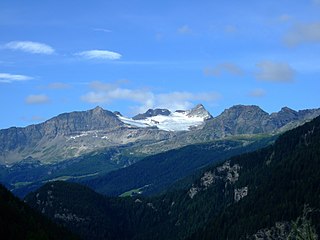
The Grisons or Graubünden, more formally the Canton of the Grisons or the Canton of Graubünden, is one of the twenty-six cantons of Switzerland. It has eleven districts, and its capital is Chur. The German name of the canton, Graubünden, translates as the "Grey Leagues", referring to the canton's origin in three local alliances, the Three Leagues. The other native names also refer to the Grey League: Grischùn in Sutsilvan, Grischun in the other forms of Romansh, and Grigioni in Italian. Rhaetia is the Latin name for the area. The Alpine ibex is the canton's heraldic symbol.

Zernez is a village and a municipality in the Engiadina Bassa/Val Müstair Region in the Swiss canton of Graubünden. On 1 January 2015 the former municipalities of Lavin and Susch merged into the municipality of Zernez.

Ilanz is a former municipality in the district of Surselva in the Swiss canton of the Grisons. The former municipality of Ilanz was congruent with the town of Ilanz. On 1 January 1978, the former municipality of Strada merged into the new municipality of Ilanz. On 1 January 2014, the municipality of Ilanz and the surrounding municipalities Castrisch, Ladir, Luven, Pitasch, Riein, Ruschein, Schnaus, Sevgein, Duvin, Pigniu, Rueun and Siat merged into the new municipality of Ilanz/Glion.

The Bernina Pass is a high mountain pass in the Bernina Range of the Alps, in the canton of Graubünden (Grisons) in eastern Switzerland. It connects the famous resort town of St. Moritz in the Engadin valley with the Italian-speaking Val Poschiavo, which ends in the Italian town of Tirano in Valtellina. The pass lies a few kilometres east of Piz Bernina, and south of Val Minor.

Vals is a village and a municipality in the Surselva Region in the canton of Graubünden in Switzerland. On 1 January 2015 the former municipality of St. Martin merged into the municipality of Vals.

Bernina District is a former administrative district in the canton of Graubünden, Switzerland. It had an area of 237.2 km2 and a population of 4,619 in 2015. It was replaced with the Bernina Region on 1 January 2017 as part of a reorganization of the Canton.

Pontresina is a municipality in the Maloja Region in the canton of Graubünden in Switzerland.

Müstair [myʃtɐir] is a village in the Val Müstair municipality in the district of Inn in the Swiss canton of Graubünden. In 2009 Müstair merged with Fuldera, Lü, Switzerland, Santa Maria Val Müstair, Tschierv and Valchava to form Val Müstair.

Scuol is a municipality in the Engiadina Bassa/Val Müstair Region in the Swiss canton of Grisons. The official language in Scuol is Romansh. On 1 January 2015 the former municipalities of Ardez, Guarda, Tarasp, Ftan and Sent merged into Scuol.

Santa Maria Val Müstair is a village in the Val Müstair municipality in the district of Inn in the Swiss canton of Graubünden. In 2009 Santa Maria Val Müstair merged with Lü, Müstair, Fuldera, Tschierv and Valchava to form the municipality of Val Müstair.

Celerina/Schlarigna is a municipality in the Maloja Region in the Swiss canton of Graubünden.

Sumvitg is a municipality in the Surselva Region in the canton of Graubünden in Switzerland.

Bivio is a village and former municipality in the Sursés in the district of Albula of the Swiss canton of Graubünden. On 1 January 2016 the former municipalities of Bivio, Cunter, Marmorera, Mulegns, Riom-Parsonz, Salouf, Savognin, Sur and Tinizong-Rona merged to form the new municipality of Surses.
Bondo is a village and a former municipality in the district of Maloja in the Swiss canton of Grisons. It is now part of the municipality of Bregaglia.

Brusio is a municipality in the Bernina Region in the canton of Grisons in Switzerland.
Soglio is a village and a former municipality in the district of Maloja in the Swiss canton of the Grisons close to the border with Italy. It is now part of the municipality of Bregaglia.
Stampa is a former municipality in the Maloja district of the Swiss canton, Graubünden. It is now part of the municipality of Bregaglia.

Val Poschiavo is a valley in the southern, Italian-speaking part of the Swiss canton of Graubünden (Grisons). The main town is Poschiavo.

Sfazù is a hamlet in the upper part of the Val Poschiavo in the canton of Graubünden, Switzerland. It lies at 1,622 metres (5,322 ft) above sea level at the point where the Val da Camp enters the Val Poschiavo. It is on the southern approach to the Bernina Pass, and is in the municipality of Poschiavo, some 7.5 kilometres (4.7 mi) north of the village of the same name. Because of the 600 metres (2,000 ft) of altitude difference between the two villages, the distance between them by road is 9 kilometres (5.6 mi), using Hauptstrasse 29 that passes close by Sfazù.

Alp Grüm railway station is a railway station in the municipality of Poschiavo, in the Swiss canton of Graubünden. It is located on the south side of Bernina Pass, on the Bernina line of the Rhaetian Railway. It serves the hamlet of Alp Grüm, which, except in summer, is accessible only from the railway. From the station, thanks mainly to the 180° curve immediately to the south, there are far-reaching views of the Palü Glacier, Lago Palu and the Puschlav.


























